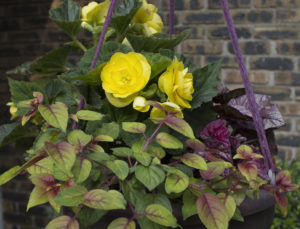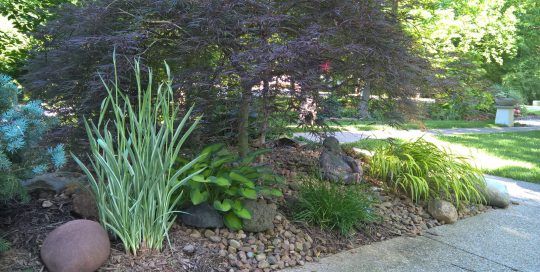When springtime rolls around, finding the coolest plants moves to the top of my priority list. I look back at the photos I’ve taken of the plants in my garden that have thrived through the summer. I look for inspiration online and in books and catalogs. And I compile a loosely-observed list of shade-loving plants for my outdoor containers.
The term “shade” is relative. It can mean anything from a sunless but bright location to a spot with two or three hours of direct sun. As the summer heats up, the wind plays a role. Check shaded containers that get a lot of wind often for moisture needs.
Shady Container Tips:
- Remember, if you’re planting in containers, you can move the whole kit-and-caboodle if it doesn’t thrive in its original location.
- Determine where you’ll be viewing your creation. If your planter is serving as a front-of-the-house accent to be viewed from a distance, consider large-leaved plants like Hostas, or one of the large coleus varieties. Planters staged in your favorite beverage-sipping spot might be filled with delicately detailed bloomers like begonias or impatiens.
- Even sun-lovers appreciate some shade when they’re first planted, especially if the day is a scorcher.
- If you’re not sure how much sun a plant will like, start it out in the shadiest spot and then try moving it gradually to a sunnier location. Plants like Coleus become more colorful and even shade-loving Fuchsia will flower better if given a bit of sun.
- If you grow houseplants, consider those that like as much natural light as possible—those are the ones that will thrive outdoors in shade, and might gradually be moved into a sunnier spot.
Plant Care
Most of us have both sunny and shady spots for outdoor containers. My garden’s darkest spot is on my front porch, which faces north and is protected by deep eaves. It’s where my most sun-shy plants can enjoy the breezes and humidity of summer without direct sun.
Just six feet away from the house, outside the protection of the eaves, is where I grow plants that enjoy more light. Here, and out further from the house is where I hang baskets of Begonias, Fuchsia, many coleus varieties, and ferns. Here are some plants I’ve had success with, either as hanging baskets or in large containers on the ground on my north side.
Best Varieties
Begonia – here are just a few of the hundreds of Begonia varieties you’ll find at your local nursery:
- Nonstop@ – more like roses, the flowers of this tuberous hybrid are not to be ignored. Their flowers measure up to four inches across, and are available in dozens of colors. They’re heat tolerant, look great in hanging baskets, and love a few hours of morning sun or several hours of filtered light.
- ‘Santa Cruz’ – one of the first varieties of Begonia boliviensis to hit the hanging basket world by storm just a few years ago, today, hybrids abound. I’m excited at the prospect of finding a new series called Groovy, introduced by Benary Plants.
- ‘Canary Wings’ is one of the easiest and most versatile Begonias to grow. Give it a bit of sun and its leaves, which are its best feature, shine like a caution light in any container. Sprinkled among its wing-shaped leaves are bright red flowers that provide the perfect accent.

Coleus (Plectranthus) – there isn’t a pot in my garden that can’t benefit from a coleus.
- ‘Colorblaze Lime Time’ (24” to 40”) or ‘Big Blonde’ (24” to 36”) are two traffic-stopping plants that can stand on their own. In fact, they’ll hog the space in a large container so I usually put them by themselves in a container or even in the garden.
- ‘Marrakesh’ (16”) – one of my favorite varieties, this colorful cutie gets along well with other well-mannered plants that like a couple hours of direct sun.
- Under the Sea ‘Sea Monkey Purple’ (8” to12”) – One of the smallest coleus you’ll find, the colorful and undulating leaves make it a candidate for up close enjoyment. The Under the Sea series was developed by the University of Saskatchewan.
Fuchsia – I’ve found Fuchsia to be fussy about sun. It turns out they love a couple hours of direct sun, and hate to be overwatered. Here is a trio of the least picky varieties.
- ‘Autumnale’ – I’d grow Fuchsia ‘Autumnale’ even if it didn’t bloom. Its shiny leaves contain shades of red and yellow, making it a great accent for anything of either color.
- ‘Firecracker’ – Here is another Fuchsia that looks great even without flowers. The upright stems are clothed in variegated silvery green and cream leaves and are dripping with bright coral flowers.
- ‘Genii’ – Hedge your blooming bets with Fuchsia ‘Genii’, its golden leaves a delicate beacon for a spot in filtered light. But this little beauty is a prolific bloomer, sporting purple pendant blossoms with bright pink sepals.

Companion or accent plants:
-
- Miniature artillery plant (Pilea microphylla-variegata) When you see it from a distance, this variegated Pilea looks like it’s covered with tiny white flowers. Mix this 10 inch tall mounding plant with other well-mannered plants for the perfect accent.
- Jade Vine (Senecio macroglossus ‘Variegatus’) The variegated jade vine is no relation to the jade plant. Its succulent cream and green leaves will trail and weave through its companion plants, are so the plan is drought tolerant. I like to use it as a trailer/weaver with my container plants. Clip it back by half and each long stem will give you two.
-
Annual geranium (Pelargonium spp)
- Fancy leaf – Grown for their intricately patterned leaves, this type of annual geranium needs less sun than most of the flowering types. ‘Distinction’ Brocade Catalina’ ‘Vancouver Centennial’ are some of the best and most easily found at garden centers.
- Ivy or hanging types– not an actual ivy plant, ivy geraniums tend to grow long, dangling stems laden with flowers. They’re more shade tolerant than their upright cousins.
Conclusion
Don’t ignore the less sun-endowed spots in your garden. Make a list of shade-lovers that can become the backbone of your shady areas. It saves disappointment later in the season when the Petunias become leggy and quit blooming. Seek out the plants with tags that indicate they like part sun or part shade. It’s the best way to start if you’re not sure.











